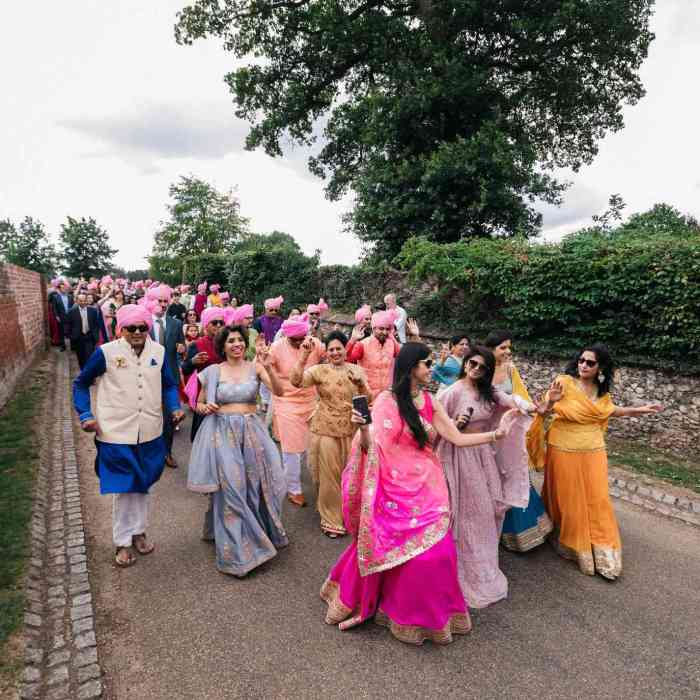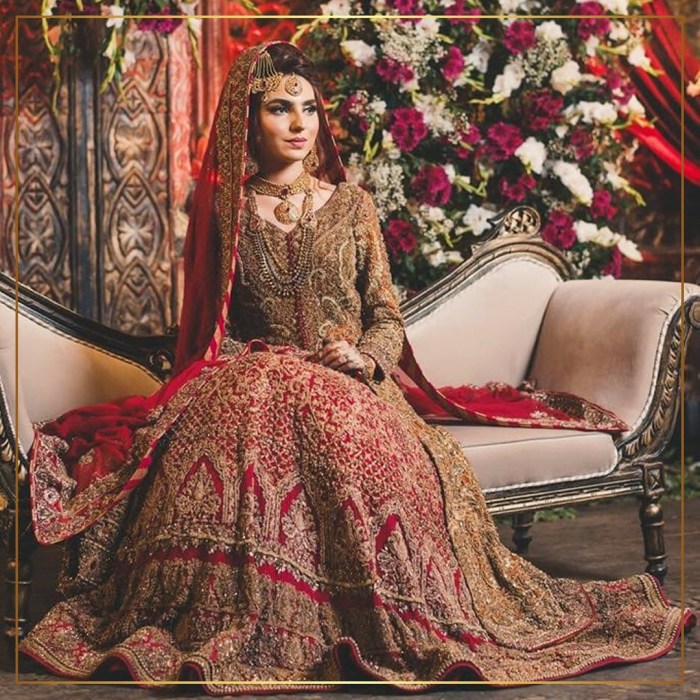Types of Indian Wedding Dresses
Indian dresses for weddings – Indian weddings are renowned for their vibrant celebrations and, of course, the stunning attire. The choice of dress is a significant aspect, reflecting personal style, regional heritage, and the occasion’s formality. Several traditional and contemporary styles are available, each with its unique characteristics.
Sarees, Lehengas, Anarkalis, and Gowns
The saree, a timeless classic, drapes elegantly around the body, showcasing its intricate designs and luxurious fabrics. Lehengas, consisting of a choli (blouse), a long skirt, and a dupatta (scarf), offer a more contemporary yet traditional look. Anarkalis, featuring a long, flared kurta (tunic) paired with churidar (trousers), provide a graceful and sophisticated silhouette. Finally, gowns, a more modern addition, offer a Western twist on traditional Indian aesthetics, often incorporating elements like embellishments and embroidery.
Comparison of Indian Wedding Dress Styles
| Style | Fabrics | Suitable Occasions | Regional Variations |
|---|---|---|---|
| Saree | Silk, brocade, net, chiffon | Weddings, receptions, ceremonies | Banarasi (North India), Kanjeevaram (South India) |
| Lehenga | Silk, velvet, brocade, net | Weddings, receptions, sangeet ceremonies | Rajasthani (West India), Gujarati (West India) |
| Anarkali | Silk, georgette, net | Weddings, receptions, mehndi ceremonies | Various regional embellishments |
| Gown | Silk, satin, velvet | Cocktail parties, receptions | Often incorporates Indian embroidery and embellishments |
Embellishments and Embroidery
Indian wedding dresses are often lavishly adorned with intricate embellishments and embroidery. Common techniques include zari (gold or silver thread work), gotta patti (lace work), aari (needlework), and zardozi (metal embroidery). These embellishments can range from subtle detailing to opulent, all-over coverage, reflecting the bride’s personal preference and the occasion’s grandeur.
Fabrics Used in Indian Wedding Dresses
The fabric choice significantly impacts the overall look and feel of an Indian wedding dress. Different fabrics offer varying levels of drape, texture, and maintenance requirements.
Fabric Properties and Suitability
- Silk: Luxurious drape, rich sheen, requires dry cleaning.
- Brocade: Heavy, intricate woven patterns, requires dry cleaning.
- Velvet: Rich texture, warm feel, requires dry cleaning.
- Net: Sheer, delicate, easy to maintain.
- Georgette: Lightweight, flowing, easy to maintain.
Silk vs. Velvet
Silk and velvet both contribute to a luxurious feel in wedding attire, but they offer distinct textures. Silk provides a smooth, flowing drape with a subtle sheen, while velvet offers a plush, rich texture with a deep pile. The choice often depends on personal preference and the overall aesthetic desired for the dress.
Colors and Trends in Indian Wedding Dresses
Traditional and contemporary color palettes influence the choice of wedding attire. While traditional reds and golds remain popular, modern brides are increasingly embracing a wider range of colors and designs.
Traditional and Contemporary Color Palettes
Traditional Indian wedding dresses often feature vibrant reds, golds, and maroons, symbolizing auspiciousness and prosperity. However, modern trends incorporate pastels, jewel tones, and even unconventional shades like blues, greens, and purples.
Popular Color Combinations
| Theme | Color Combination 1 | Color Combination 2 | Color Combination 3 |
|---|---|---|---|
| Traditional | Red and Gold | Maroon and Gold | Crimson and Emerald |
| Modern | Pastel Pink and Silver | Navy Blue and Gold | Emerald Green and Gold |
| Contemporary | Peach and Rose Gold | Lavender and Silver | Dusty Rose and Champagne |
Styling Indian Wedding Dresses
Styling an Indian wedding dress involves carefully selecting jewelry, accessories, and hairstyles to complement the chosen outfit and enhance the overall look.
Jewelry and Accessories

Source: brides.com
| Dress Style | Jewelry Option 1 | Jewelry Option 2 | Accessories |
|---|---|---|---|
| Saree | Heavy necklaces, bangles | Jhumkas (earrings), maang tikka (forehead ornament) | Potli bag, clutch |
| Lehenga | Statement necklace, earrings | Choker necklace, bangles | Potli bag, clutch |
| Anarkali | Jhumkas, bangles | Necklace, earrings | Potli bag, clutch |
| Gown | Statement necklace, earrings | Choker necklace, bracelet | Clutch |
Hairstyles
Hairstyles should complement the dress and jewelry. A sleek bun or a braided hairstyle works well with heavy jewelry, while loose curls or a half-updo can create a softer look.
Regional Variations in Indian Wedding Dresses
Indian wedding attire varies significantly across different regions, reflecting unique cultural traditions and artistic styles.
Regional Distinctions in Wedding Attire
- South India (e.g., Tamil Nadu): Kanjeevaram silk sarees, known for their intricate gold zari work, are extremely popular.
- North India (e.g., Rajasthan): Lehengas with heavy embroidery and mirror work are prevalent, often incorporating bright colors.
- West India (e.g., Gujarat): Bandhani sarees, known for their tie-dye patterns, and Gharchola sarees are commonly worn.
Comparison of Styles
The contrast between a South Indian Kanjeevaram saree and a Rajasthani lehenga highlights the diversity of Indian wedding attire. The Kanjeevaram saree’s elegance lies in its subtle yet rich weave and traditional motifs, while the Rajasthani lehenga showcases bold colors, intricate embroidery, and mirror work, emphasizing vibrancy and embellishment.
Budget Considerations for Indian Wedding Dresses: Indian Dresses For Weddings
Budget significantly impacts the choice of fabric, embellishments, and overall design. However, it’s possible to find affordable yet elegant options.
Budget Impact on Dress Selection
Higher budgets allow for the use of luxurious fabrics like pure silk and heavy embellishments like zardozi. Lower budgets might necessitate opting for blends or lighter embellishments, but still achieve a stunning look.
Price Ranges

Source: wedmeplz.com
Price ranges vary widely depending on the type of dress, fabric, and embellishments. A simple saree might cost a few hundred dollars, while a heavily embellished lehenga could cost several thousand.
Finding Affordable Options
Consider renting a dress, choosing less expensive fabrics, opting for simpler embellishments, or shopping at local markets and boutiques for more budget-friendly options.
Illustrative Descriptions of Indian Wedding Dresses
Richly Embroidered Silk Saree
Imagine a vibrant red Banarasi silk saree, its surface alive with intricate gold zari work depicting floral motifs and paisley patterns. The silk’s luxurious drape and subtle sheen enhance the overall richness. The fine craftsmanship is evident in the meticulous detailing of each thread, creating a visually stunning masterpiece. The deep crimson base complements the gold embroidery, radiating a sense of traditional opulence.
Modern Minimalist Lehenga
A modern minimalist lehenga in a soft ivory silk showcases a clean, contemporary design. The skirt falls in graceful pleats, while the choli features delicate embroidery around the neckline and sleeves. The simplicity of the design is balanced by the luxurious drape of the silk, creating an elegant and understated look. The overall aesthetic is one of refined sophistication.
Traditional Banarasi Silk Saree, Indian dresses for weddings
A traditional Banarasi silk saree, steeped in history and heritage, is a testament to centuries of weaving tradition. The rich, deep gold fabric is adorned with intricate patterns of floral motifs and paisleys, woven with fine silver and gold zari threads. The saree’s weight and texture speak of its quality, while its historical significance adds a layer of cultural depth to its visual appeal.
The meticulous craftsmanship is evident in the intricate detailing and the harmonious blend of colors and patterns.
Indian wedding attire offers a breathtaking array of choices, from vibrant lehengas to elegant sarees. The diverse styles reflect the rich cultural tapestry of India. For a different perspective on bridal fashion, consider the unique style of Elle King’s wedding dress, as seen here: elle king wedding dress. Ultimately, both Western and Indian wedding dresses prioritize celebrating the couple’s special day with memorable style.
Commonly Asked Questions
What is the difference between a lehenga and a saree?
A lehenga is a three-piece outfit consisting of a long skirt, a choli (blouse), and a dupatta (scarf). A saree, on the other hand, is a single, long piece of fabric draped around the body in various styles.
How do I choose the right fabric for my wedding dress?
Consider the season, the occasion’s formality, and your personal preference. Silk is luxurious and drapes beautifully, while brocade offers rich texture, and velvet is ideal for cooler weather. Net is often used for lighter, more modern styles.
Where can I find affordable Indian wedding dresses?
Explore online marketplaces, local boutiques, and bridal shops that offer a range of price points. Consider opting for simpler embellishments or choosing a less expensive fabric to stay within your budget.
How far in advance should I start looking for my wedding dress?
It’s recommended to start shopping at least 6-12 months before your wedding to allow ample time for alterations and customization.
